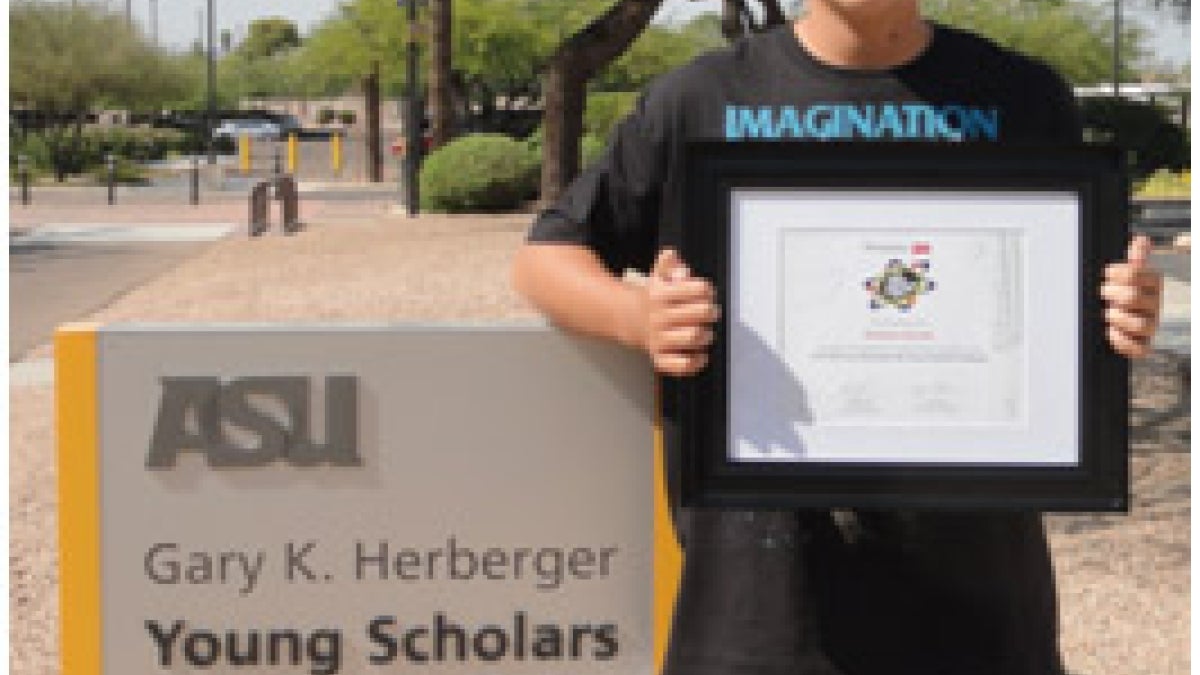Human-dog communication aid earns accolades for young scientist

An invention enabling a dog to alert its owner when it’s “time to go” has resulted in national recognition for a student at ASU’s Gary K. Herberger Young Scholars Academy.
Nicholas Planidin, 13, is Arizona’s sole Merit Winner in the 2012 National Discovery Education 3M Young Scientist Challenge. Planidin attends the Herberger Academy, a school for gifted students that is an initiative of ASU’s Mary Lou Fulton Teachers College.
In January, students nationwide were asked to create a short video describing a new innovation or solution that could solve or impact an everyday problem related to the way we move, keep ourselves healthy or make a difference. Only one student per state was selected as state Merit Winners in this year’s competition and will each receive a 3M Innovation Prize Package.
Planidin’s video describes his invention, the Doggie Detector, which enables a dog to alert its master that its bladder is full, even when the owner is out of hearing or sight range.
“My innovation was inspired by my own dog, Odie,” Planidin said. “I used technology and engineering to create a transmitting device which will make me aware when my dog needs to go outside. Once Odie steps on the device, a message is sent directly to me with an alert that he needs to go outside.”
The Doggie Detector can have a significant positive impact on the health of dogs, Planidin said.
“Scientific studies show that when dogs have to wait to urinate, the risk of a urinary tract infection or acute cystitis can occur,” he said. “Cystitis is inflammation in the bladder, and sometimes stones can form in the urinary tract. Bacteria begin to overwhelm a dog’s immune system and that may lead to kidney disease, which can be fatal for dogs.”
Planidin is working to obtain a patent for the Doggie Detector.
“My favorite subject in school has always been science,” Planidin said. “Science is creative and challenging at the same time. Science is fun, interactive and really stretches your imagination.”
The Herberger Academy, located on ASU’s West campus, is now in its second academic year and has attracted gifted students from across metropolitan Phoenix. The academy is Arizona’s first university-based school specifically designed to meet the unique educational, social and emotional needs of gifted young adolescents.
“Our curriculum breaks down barriers between subject areas to make learning more meaningful for students,” said Kimberly Lansdowne, executive director of the Herberger Academy. “We also have more flexibility than a traditional school in terms of enabling students to spend additional time pursuing specific interests they are passionate about.”
Planidin said he is exploring the idea of obtaining a doctorate in marine biology or physics as a career path. “The teaching staff at the Herberger Academy has been instrumental in my determination and academic achievement,” he said. “The students are encouraged to excel above and beyond the ‘norm’ which provides a positive and challenging learning environment.
“I believe too there are no boundaries in technology and robotics; combined with my science acumen, innovation, curiosity and communication skills I have great expectations of myself and what I will be able to give back to society. If you can think it, then you can create it.”
“This year’s Discovery Education 3M Young Scientist Challenge finalists embody the innovative spirit that will drive them to pursue careers in science, technology, engineering and math, and thrive in a competitive global workforce,” said Bill Goodwyn, CEO of Discovery Education. “This unique challenge allows our country's next generation of leaders to interact and build relationships with real-world scientists to truly inspire curiosity and see STEM as a potential career path.”
For more information about ASU’s Gary K. Herberger Young Scholars Academy, call (602) 543-8274 or visit http://herbergeracademy.asu.edu/.